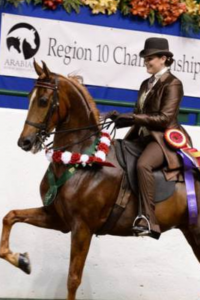One of my favorite ways to accessories my show outfit is with a tie. But if you’re anything like me, every time I open my garment bag only to discover my tie hanging undone, I am left in a frantic situation where I have to scramble to find my dad or the closest person around who can tie it for me.
Therefore, I decided it was time for me to finally take on the task of learning how to tie my own tie in prevention of these frenzied situations.
So, no matter if you have never been taught how to tie a tie properly, are a little rusty, or just want a fresh trick or two to upgrade your style, get ready to get out your sharpest looking tie and a mirror. With some patience and practice you, too, can learn how to tie a fabulous tie.
Below, I have listed four of the most popular techniques, starting with the easiest. Try them all and decide which one suits you best.
1) The Four-in-Hand
The Four-in-Hand Knot makes for a narrow, discreet and slightly asymmetrical tie knot. While this knot can be worn on anyone, it looks especially well on those with shorter necks, as the knot’s shape has a bit of a slimming effect.
To tie the Four-in-Hand Knot, simply follow these steps:
1) To start, the wide end of your tie should be hanging on the side of your dominant hand. If you are right handed, begin by putting the wide end (“W”) of your tie on the right, extending about 12 inches below the Narrow end (“N”) on the left. If you are left-handed, the wider end should be hanging on your left side.
2) Cross the wide end over the narrow end.
3) Turn the wide end back underneath the narrow end.
 4) Continue by bringing the wide end back over in front of the narrow end again.
4) Continue by bringing the wide end back over in front of the narrow end again.
 5) Next, pull the wide end up and through the loop around your neck.
5) Next, pull the wide end up and through the loop around your neck.
6) Hold the front of the knot loosely with your index finger and bring the wide end down through the front loop.
7) Finally, remove your finger and tighten the knot to the collar by holding the narrow end and sliding the knot up.
It’s as simple as that!
2) The Half-Windsor
The Half-Windsor Knot is a good alternative to the Four-In-Hand method. The knot is bigger, symmetrical and triangular, and is considered to offer a more upscale look than the Four In Hand. It works best with somewhat wider neckties made from light to medium fabrics.
Here’s how to tie it:
 1) To start, (as with the Four In Hand) the wide end of your tie should be hanging on the side of your dominant hand. If you are right handed, begin by putting the wide end (“W”) of your tie on the right, extending about 12 inches below the Narrow end (“N”) on the left. If you are left-handed, the wider end should be hanging on your left side.
1) To start, (as with the Four In Hand) the wide end of your tie should be hanging on the side of your dominant hand. If you are right handed, begin by putting the wide end (“W”) of your tie on the right, extending about 12 inches below the Narrow end (“N”) on the left. If you are left-handed, the wider end should be hanging on your left side.
2) Cross the wide end of the tie over the narrow end.
3) Bring the wide end around and under the narrow end.
4) Next, bring the wide end up.
5) Pull the wide end through the loop and to the right.
6) Bring the wide end around the front, over the narrow end from right to left.
7) Again, bring the wide end up and through the loop again.
8) After, bring the wide end through the knot in the front.
9) And – using both hands – tighten the knot, drawing it up to the collar. (You want your knot to look a bit wider than the Four In Hand knot.)
And there you have it! That is all there is to the Half-Windsor Knot.
3) The Windsor-Knot
The Windsor Knot – a thick, wide and triangular tie knot – is a more formal alternative to the Half-Windsor. This tie knot looks especially well on those with longer necks as its wide form shortens the perceived height of the neck a little bit.
Here’s how to do it:
 1) To start, the wide end of your tie should be hanging on the side of your dominant hand. If you are right handed, begin by putting the wide end (“W”) of your tie on the right, extending about 12 inches below the Narrow end (“N”) on the left. If you are left-handed, the wider end should be hanging on your left side.
1) To start, the wide end of your tie should be hanging on the side of your dominant hand. If you are right handed, begin by putting the wide end (“W”) of your tie on the right, extending about 12 inches below the Narrow end (“N”) on the left. If you are left-handed, the wider end should be hanging on your left side.
2) Cross the wide end over the narrow end.
3) Bring the wide end up through the loop between the collar and your tie.
4) Then bring the wide end back down.
5) Pull the wide end underneath the narrow end and to the right, back through the loop and to the right again so that the wide end is inside out.
6) Bring the wide end across the front from right to left.
7) Pull the wide end up through the loop again.
8) Bring the wide end down through the knot in the front.
9) Finally – using both ends – tighten the knot carefully and draw it up to the collar.
With a bit of practice you will be laughing at how easy it is.
4) The Pratt-Shelby Knot
The Pratt Knot (also known as the Shelby Knot) is fairly wide, but not as wide as the Windsor Knot. It is best suited for somewhat wider ties that are made out of light to medium fabrics.
To tie it, follow these steps:
 1) Start with the necktie inside out. As always, the wide end of your tie should be hanging on the side of your dominant hand. If you are right handed, begin by putting the wide end (“W”) of your tie on the right, extending about 12 inches below the Narrow end (“N”) on the left. If you are left-handed, the wider end should be hanging on your left side.
1) Start with the necktie inside out. As always, the wide end of your tie should be hanging on the side of your dominant hand. If you are right handed, begin by putting the wide end (“W”) of your tie on the right, extending about 12 inches below the Narrow end (“N”) on the left. If you are left-handed, the wider end should be hanging on your left side.
2) Cross the wide end under the narrow end.
3) Take the wide end over and under the narrow end.
4) Pull the loop down and tighten.
5) After, take the wide end over to the right.
6) Pull the wide end up, behind the loop.
7) Finally, bring the wide end through the knot and tighten gently.
Voilá! The Pratt Knot.
TO MAKE A DIMPLE:
 It is always important to me that my tie has a dimple. Such a simple detail can add both sophistication and depth to your show outfit.
It is always important to me that my tie has a dimple. Such a simple detail can add both sophistication and depth to your show outfit.
Start by choosing the right tie. Some ties are easier to dimple than others. The best and easiest to dimple are ones made from coarser fabrics such as fine ribbed textured silk. The coarser fabric helps to create more friction, preventing the dimple from loosing its shape.
The perfect dimple is made before you tighten the knot. To create it, start by placing your index finger in the fabric directly under the knot while gently squeezing the sides of the fabric as you tighten the knot by pulling down on the wide end of the tie. The dimple should be centered in the middle of your knot.





















































